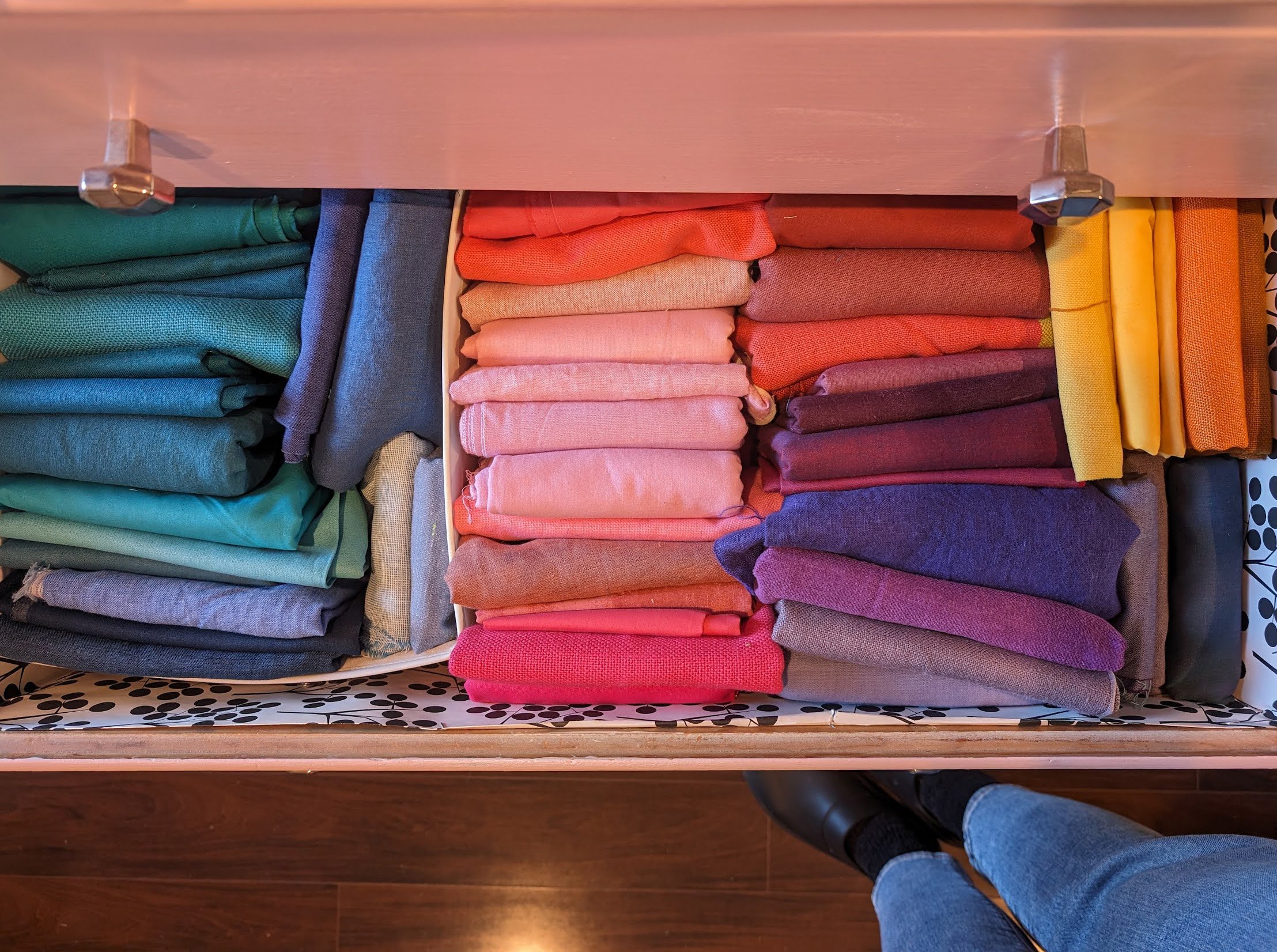Material Matters
Advice on How to pick a fabric:
When starting a new piece it is essential to think about the ground cloth you are going to use. In the same way a painter might prep a canvas, or stretch their paper, embroidery cloth needs consideration. The fact is, you can stitch on most any fabric if you try hard enough, but some are more conducive than others. All resources used are linked at the bottom. Here are a few things to think about with fabric preparation when planning your piece:
Ground Color
If you are new to embroidery, a white or cream cloth is your best choice. White is a neutral ground to show off thread colors and see clearly where you are stitching. White is also easy to mark and see your pattern on. Whether you are tracing it on with a pencil or a water soluble marker, white/neutral allows it to be visible.
If you are a bit more daring, try a different ground color. The background can change the whole vibe of your piece. In the same way painting a room can profoundly change the mood in a room, changing the ground color shifts the color harmony. However, the darker the fabric, the harder it will be to see the pattern. I will write more about this below, but suffice to say, I wouldn't use a dark ground on your first embroidery.
Types of Fabric
Linen
I love to stitch on linen. It is the perfect amount of texture and softness, and the weave is slightly looser than a traditional cotton fabric. Linen comes in so many different weights. If you can go into a fabric store and feel the fabric yourself, odds are you will have a better outcome than online ordering. That being said, a sure bet (IMO) is the Robert Kaufman “Essex Linen Cotton” blend. It comes in a ton of gorgeous colors and it is a great weight for embroidery. It is 55% Linen, 45% cotton. It feels sturdy and durable, plus a fairly tight weave that won’t get wonky while stitching. Alternatively, Robert Kaufman “Essex Yarn Dyed,” is also fabulous. This one is also 55% Linen, 45% cotton but is more textured looking. The warp and weft are two different colors, so it adds dimension to the fabric. Oftentimes, both of these can be found in your local quilt shop. If you can, pop in and give them a look. If you don’t have a shop near you, I have had really excellent service from Yuki at Fabric Divas on Etsy (I have no affiliation, just a fan!)
Cotton
If linen is not available or affordable, cotton is a-ok. I don’t recommend polished cotton or a sateen type fabric as they are a tighter weave. I am currently doing some work on a sateen and it looks lovely to work on. However the weave is SO tight that if I poke in the wrong place with the needle it leaves a hole. The cloth is unforgiving, so every wrong move leaves a tiny perforation. A looser weave of linen or cotton can be massaged into forgiveness if you make a mistake.
Spoonflower
If you are a Spoonflower fan, their “linen cotton canvas” works pretty well for embroidery. It is a heavier weight than I usually use, but the results are fantastic. I did two different pieces on the Spoonflower and it seemed like my stitches were neater than ever. The finished work (see below) turned out very crisp and tidy.
Felt
Proceeding with caution would be my advice. If you are going to use it, it must be a wool blend, or 100% wool felt. Most craft and fabric stores sell acrylic felt which is thin and tears easily. Wool felt is a lot more sturdy and works well for decorations, pennants, tree skirts, embroidered brooches, etc. I love it for quick projects like Christmas ornaments. Felt is great for applique too. It doesn't fray or need to have finished edges. I wouldn't necessarily encourage felt use for a regular hoop pattern. It is bulky to work with and can get stretched out of shape. If you use it in a hoop, the hoop can cause creases that are hard to work out. In my embroidery practice, it’s not a great fit, but it’s worth a try.
Other fabric ideas
If you are up for it, try looking at your local thrift shop. An old linen shirt, or even bedding can work well as a ground cloth (and good for the environment.) There are tons of artists upcycling clothing with embroidery and making stunning work. Or you can simply cut it up for smaller pieces.
Hope this helps you get started!
-km
Resources:
For Essex Cottons: Fabric Divas on Etsy https://www.etsy.com/shop/fabricdivas
For Wool Felts: The Felt Pod on Etsy https://www.etsy.com/shop/TheFeltPod
or Over the River Felt https://www.etsy.com/shop/OverTheRiverFelt
Printable Fabric (DIY) https://a.co/d/iWEZ7bM
Spoonflower: https://www.spoonflower.com/collections/801124-embroidery-patterns-by-kathrynmurray
Gouache for Dark Fabrics: https://a.co/d/4MjHiZy
White Gel Pen: https://a.co/d/cYQNOIS
Stick & Stitch: https://a.co/d/iZ7CYET
My favorite lightbox: https://a.co/d/gsRkM7E
Water Soluble Marker: https://a.co/d/06mDO1y
My favorite type of hoops: https://a.co/d/hc7UTJP






